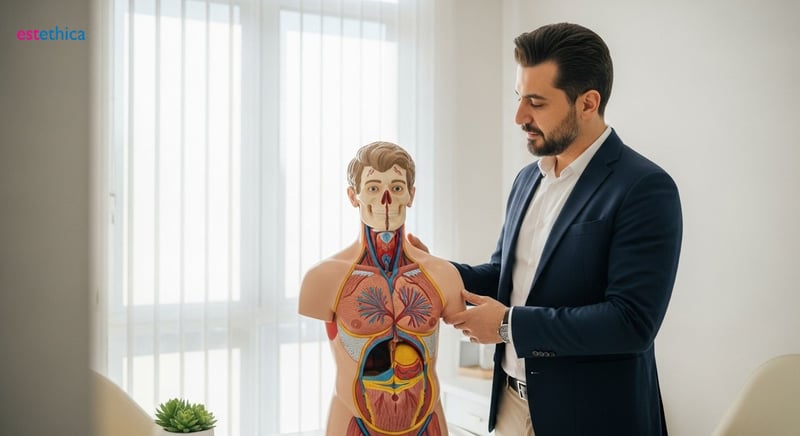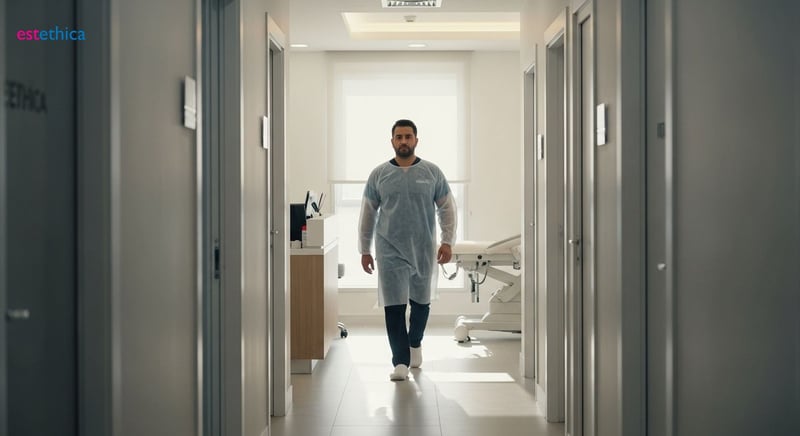Gynecomastia Solutions: Regain Your Chest Confidence
Discover effective pathways to tackle gynecomastia and regain your chest confidence with expert treatments and lifestyle strategies.
Gynecomastia, often referred to as enlarged male breasts, is a common condition affecting men of all ages, causing emotional and physical distress. Understanding its causes and exploring effective treatments can help regain confidence and improve your quality of life. This article delves into the causes, available treatment options, recovery processes, and lifestyle changes that can help reduce its impact.
Decoding Gynecomastia: What Causes Enlarged Male Breasts?
Understanding the Hormonal Imbalance Behind Gynecomastia
Gynecomastia arises from an imbalance in the levels of estrogen and testosterone in men, leading to swollen breast gland tissue. This condition isn't merely a cosmetic concern; it's often rooted in complex hormonal fluctuations that affect the delicate balance within the male body. A proper understanding of these hormonal dynamics is essential for effective management and treatment. The gynecomastia condition may also be affected by aging process.
Factors Contributing to Gynecomastia
- Aging: As men age, testosterone levels naturally decline, which can disrupt the estrogen-testosterone ratio, potentially leading to gynecomastia.
- Medications: Certain medications, such as anti-androgens, anabolic steroids, and antidepressants, can interfere with hormone levels and increase the risk of developing enlarged male breasts.
- Underlying Health Conditions: Conditions like liver disease, kidney failure, and thyroid disorders can affect hormone production and metabolism, thereby contributing to gynecomastia.
Lifestyle choices also have a significant impact; for instance, excessive alcohol consumption and the use of recreational drugs can disrupt hormonal balance. Managing gynecomastia effectively involves targeting these root causes and tailoring treatment strategies accordingly. Identifying these triggers aids in formulating personalized approaches to mitigate and resolve the condition. For example, addressing medication-induced gynecomastia might involve adjusting or changing the prescription under medical supervision.
Common Causes of Hormonal Imbalance
- Hormone Therapy: The use of hormones for various medical reasons sometimes leads to hormonal imbalances, causing side effects such as man boobs.
- Medical Treatments: Chemotherapy and radiation treatments can disrupt the endocrine system, leading to secondary hormonal imbalances.
- Genetic Predisposition: Some men may have a genetic predisposition to hormonal imbalances that make them more susceptible to developing gynecomastia.
Ultimately, understanding the interplay between these factors is crucial in addressing gynecomastia. Early detection and intervention can significantly improve outcomes and enhance the quality of life for those affected by enlarged male breasts.

Male Breast Reduction: Surgical and Non-Surgical Pathways
Surgical Options for Gynecomastia Correction
Surgical interventions, such as liposuction and mastectomy, are effective options for male breast reduction. Liposuction is particularly useful when excess fat is the primary cause of enlarged male breasts. This procedure involves removing fat through small incisions, leading to a more contoured chest. Mastectomy, on the other hand, is more appropriate when gynecomastia involves significant glandular tissue. The surgeon removes this tissue to create a flatter, more masculine chest contour. According to a study published in the "Aesthetic Surgery Journal," surgical approaches for gynecomastia have a patient satisfaction rate of over 85%, highlighting their effectiveness. Esthetica Global is known for its excellence in surgical treatments for gynecomastia, offering personalized surgical plans tailored to each patient's specific needs.
Non-Surgical Methods and Lifestyle Adjustments
- Hormone Regulation: Medications can help balance hormone levels, particularly in cases where gynecomastia is due to hormonal imbalances. For example, selective estrogen receptor modulators (SERMs) can block the effects of estrogen in breast tissue.
- Diet and Exercise: A balanced diet and regular exercise can reduce overall body fat, which can, in turn, reduce chest fat. For example, incorporating strength training exercises that target the chest muscles can help improve chest appearance.
- Medical Supervision: Regular consultations with healthcare providers can help monitor the condition and adjust treatment plans as needed. For example, routine check-ups can help identify any underlying health issues contributing to gynecomastia.
Non-surgical methods focus on addressing the underlying causes of gynecomastia and making lifestyle changes to reduce overall body fat. For example, managing conditions like obesity and hormonal imbalances through medication and lifestyle adjustments can significantly reduce the appearance of enlarged male breasts. Esthetica Global emphasizes the importance of a comprehensive approach, including lifestyle modifications and medical supervision, to achieve the best possible outcomes for its patients. Esthetica Global provides detailed, customized health plans to address specific needs.
Comparing Surgical and Non-Surgical Options
- Effectiveness: Surgery generally offers more immediate and noticeable results, as it directly removes excess fat and glandular tissue. However, it involves risks such as scarring and complications from anesthesia.
- Recovery Time: Non-surgical methods typically have no downtime, but results may take longer and may not be as significant. Surgical options require recovery time, potentially involving swelling and discomfort.
- Suitability: Non-surgical options are best suited for mild cases of gynecomastia or when hormonal imbalances are the primary cause. Surgical options are more effective for moderate to severe cases or when there is a significant amount of glandular tissue.
Choosing between surgical and non-surgical options depends on the severity of the gynecomastia, the underlying causes, and the patient's personal preferences. Consulting with healthcare professionals is essential to get a thorough evaluation and personalized treatment plan. Esthetica Global's team of experts can provide comprehensive assessments and guide individuals through the best options tailored to their specific needs. The goal is to achieve a natural-looking and aesthetically pleasing chest contour, improving confidence and quality of life.

Gynecomastia Surgery Recovery: What to Expect Post-Procedure
Navigating the Initial Recovery Phase After Gynecomastia Surgery
The initial recovery phase following gynecomastia surgery is pivotal for achieving optimal results. Patients are typically fitted with compression garments immediately post-procedure to minimize swelling and support the healing tissues. Managing discomfort is a key aspect, with pain usually controlled through prescribed medication. Resuming light activities gradually is encouraged to promote circulation and prevent stiffness. Proper care during this period is essential for ensuring that the surgical site heals correctly and that the final aesthetic outcome meets expectations. For instance, avoiding strenuous activities for at least four to six weeks is generally advised to prevent complications.
Key Steps for a Smooth Gynecomastia Surgery Recovery
- Compression Garments: Wearing prescribed compression garments helps reduce swelling and supports the chest contours, typically for several weeks.
- Pain Management: Utilizing prescribed pain medication as directed ensures comfort during the initial days following the surgery.
- Wound Care: Following the surgeon's instructions for wound care helps prevent infection and promotes optimal healing of the incision sites.
Most patients find they can return to normal activities within a few weeks, but complete recovery can vary depending on individual circumstances. For example, a younger, healthier individual might experience a quicker recovery compared to an older person with underlying health issues. Factors such as overall health, adherence to post-operative instructions, and the extent of the surgical procedure all play a role in determining the timeline for full recovery. Esthetica Global provides comprehensive post-operative care plans to guide patients through each stage of recovery, ensuring they receive the support and information needed for a successful outcome. For example, Esthetica Global offers detailed guidelines on how to care for the surgical site, manage pain, and gradually increase activity levels.
Timeline of Gynecomastia Surgery Recovery Aftercare
- First Week: Focus on rest, managing pain with medication, and keeping the surgical site clean and dry.
- Two to Four Weeks: Gradually increase activity levels, continue wearing compression garments, and attend follow-up appointments with the surgeon.
- Several Months: Swelling continues to subside, and the final results of the surgery become more apparent as the tissues fully heal.
The immediate post-operative phase involves managing discomfort and monitoring the surgical site for any signs of infection. As healing progresses, physical activities can be gradually reintroduced, but it's vital to avoid overexertion. Long-term recovery involves allowing the body to fully adjust to the changes and ensuring that the results are maintained through a healthy lifestyle. Esthetica Global provides continuous support throughout the recovery period, offering guidance on exercise, nutrition, and overall well-being to help patients achieve and maintain their desired results. For instance, Esthetica Global can recommend specific exercises to help tone the chest muscles and maintain the new contour achieved through surgery. Regular follow-ups and personalized advice are integral to the comprehensive care offered ensuring that patients achieve the best possible outcome from their male breast reduction procedure.

Beyond Surgery: Lifestyle Tweaks to Minimize Man Boobs
Practical Lifestyle Adjustments for Managing Gynecomastia
Simple lifestyle changes can have a significant impact on reducing gynecomastia. Regular exercise targeting chest fat reduction, along with dietary adjustments and maintaining a healthy weight, can help manage symptoms and improve overall chest appearance. Incorporating these changes into your daily routine may lead to noticeable improvements and increased self-confidence for those dealing with enlarged male breasts. For example, focusing on a combination of cardio and strength training can help reduce overall body fat and build muscle definition in the chest area.
Effective Strategies for Reducing Male Breast Size
- Balanced Diet: Consuming a diet rich in fruits, vegetables, lean proteins, and whole grains can help reduce overall body fat and, consequently, the size of male breasts. For instance, meals high in fiber and low in processed sugars can stabilize hormone levels.
- Regular Exercise: Incorporating both cardiovascular exercises (like running and swimming) and strength training (such as chest presses and push-ups) can reduce chest fat and improve muscle tone. Aim for at least 150 minutes of moderate-intensity exercise each week.
- Avoid Alcohol and Drugs: Limiting alcohol consumption and avoiding recreational drugs can help maintain hormonal balance, reducing the likelihood of gynecomastia. Alcohol can disrupt the liver's ability to regulate hormones.
Making informed choices about what you eat and how you exercise is crucial for managing gynecomastia naturally. Understanding the impact of these choices on your body can empower you to take control and improve your physical appearance and overall health. For instance, those who engage in regular physical activity and maintain a balanced diet often experience a significant reduction in the appearance of man boobs over time. At Esthetica Global, we advocate for holistic strategies that combine medical insights with lifestyle modifications to ensure the best possible outcomes for our patients dealing with gynecomastia.
Integrating Lifestyle Tweaks into Your Daily Routine
- Start Slowly: Begin by gradually incorporating small changes into your daily routine, such as walking for 30 minutes each day or swapping sugary drinks for water.
- Set Realistic Goals: Establish achievable fitness and dietary goals to avoid feeling overwhelmed. For example, aim to lose 1-2 pounds per week through a combination of diet and exercise.
- Stay Consistent: Consistency is key to seeing long-term results. Stick to your exercise and dietary plans as much as possible, even when you don't feel like it.
Consistency in these lifestyle adjustments is crucial for long-term success. By making these changes a part of your daily life, you can effectively manage the symptoms of gynecomastia and enhance your overall quality of life. These modifications promote not only physical well-being but also boost self-esteem as you witness positive changes in your body. Esthetica Global supports these efforts by providing expert guidance and personalized advice tailored to individual needs and goals from experienced specialists in gynecomastia. We believe that a combination of professional medical treatment and personal commitment to a healthy lifestyle offers the most effective path to resolving issues related to enlarged male breasts.
Understanding Gynecomastia: Causes, Symptoms, and Treatments
Advanced Liposuction and Mastectomy Techniques for Gynecomastia Correction
Comprehensive Post-Operative Care and Lifestyle Adjustments for Sustained Results
Frequently Asked Questions
What causes gynecomastia, and how is it different from pseudogynecomastia?
What are the non-surgical options for male breast reduction?
What can I expect during the gynecomastia surgery recovery time?
Besides surgery, how can I reduce male breast size through lifestyle changes?
Ready for award-winning aesthetic services and expert care?
📞 Call Us Now for Your Free Consultation!